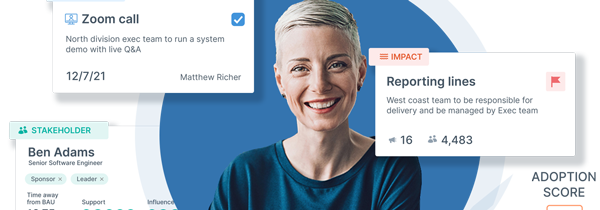Change Management Model Guide
We've outlined the world's most prominent change management methodologies and models to help you choose the right approach for your change.
 Step-by-step change methodologies
Step-by-step change methodologies
Step-by-step change methodologies (also known as 'linear' methodologies) prescribe a recommended pathway of stages or phases, consisting of particular activities to work through in order to achieve lasting change.
 Individuals' experience of change
Individuals' experience of change
Rather than showing how to implement a change project from an organizational perspective, these two models focus on the psychological journey through which individuals typically move as they experience change. These models are useful when considering change from the perspective of the individual.
 Organizational change capability
Organizational change capability
These three models prescribe broad interconnected organizational competencies that are required for effective change management. Organizations that wish to build the ability to make successful changes (change agility) can use the competencies as benchmarks to work towards.
ADKAR Model for Change Management
ADKAR is an acronym that describes the five stages that individuals ideally progress through in order to successfully move through a change.
ADKAR goal |
Awareness |
Desire |
Knowledge |
Ability |
Reinforcement |
View how the Change Activation Toolkit supports this model
ADKAR is Prosci's model for understanding the shifts that individuals make rather than a step-by-step methodology for implementing organizational changes.
The ADKAR change management model was first published in the 1998 book "The Perfect Change" by Jeff Hiatt, founder and CEO of Prosci Research. See Hiatt. J.M. (2006) ADKAR: a Model for change in business, government and our community.
External link: https://www.prosci.com/adkar/adkar-model
Agile Management
Agile Project Management and Agile Management are increasingly utilized by organisations outside of the realm of software development. Agile has been adopted by organizations to describe the process of developing new products rapidly through collaboration despite evolving requirements.
The following 5 values should be adhered to by groups wishing to successfully develop products quickly that are fit for purpose despite continually shifting requirements.
Agile Value |
Individuals & interactions |
Working software |
Customer collaboration |
Responding to change |
View how the Change Activation Toolkit supports this model
These 12 Agile Principles are the principles that groups should follow in order to achieve agile development capability.
Agile Principle |
1. Customer satisfaction by rapid delivery |
2. Welcome changing requirements |
3. Working software delivered frequently |
4. Working software the principle measure of progress |
5. Sustainable development, able to maintain a constant pace |
6. Close, daily cooperation between business people & developers |
7. Face-to-face conversation is the best form of communication |
8. Projects are built around motivated individuals who should be trusted |
9. Continuous attention to technical excellence & good design |
10. Simplicity - the art of maximizing the amount of work not done - is essential |
11. Self-organizing teams |
12. Regular adaptation to changing circumstances |
View how the Change Activation Toolkit supports this model
Adaptive project life cycle, a project life cycle, also known as change-driven or agile methods, that is intended to facilitate change and require a high degree of ongoing stakeholder involvement. Adaptive life cycles are also iterative and incremental, but differ in that iterations are very rapid (usually 2-4 weeks in length) and are fixed in time and resources.
- Project Management Institute, A Guide to the Project Management Body of Knowledge (PMBOK Guide), Fifth Edition
AIM (Accelerated Implementation Methodology)
The Accelerated Implementation Methodology features 6 goals that are designed to be approached in a linear manner in order to achieve a successful change.
AIM goal |
Define the Implementation |
Generate Sponsorship |
Build Change Agent Capability |
Develop Target Readiness |
Communication |
Develop Reinforcement Strategy |
View how the Change Activation Toolkit supports this model
External link: http://www.imaworldwide.com/aim-change-management-methodology-description
Beckhard and Harris Change Management Process
The Beckhard and Harris Change Management Process is seven step linear process for implementing a change.
Beckhard and Harris phase |
Establishing the need for change |
Building the change team |
Creating vision and values |
Communicating and engaging |
Empowering others |
Noticing improvements and energizing |
Consolidating |
View how the Change Activation Toolkit supports this model
Beckhard and Harris' originally formula for change (sometimes attributed to David Gleicher) was a mathematical equation for describing how resistance to change can be overcome within an organization:
Dissatisfaction x Vision x First steps > Resistance to change
The formula suggests that the three components dissatisfaction, vision and first steps must be present in a sufficient quantity to overcome resistance to change.
Boston Consulting Group (BCG) Change Delta
Boston Consulting Group's 'Change Delta' approach to change management is a non-linear approach to change featuring four 'Change Deltas' that organizations require in order to effectively manage portfolios of change successfully. Each of the change deltas is an ongoing process and feeds in and reinforces the other deltas in building long lasting capability.
BCG Change Delta factors |
Executional Certainty |
Enabled Leaders |
Engaged Organization |
Governance & PMO |
View how the Change Activation Toolkit supports this model
External link: https://www.bcg.com/expertise/capabilities/people-organization/change-delta.aspx
Bridges Leading Transition Model for Change
The Bridges Leading Transition Model for Change features 3 overarching stages as well as suggested activities within each of these stages.
Bridges stage | Specific activity |
Letting Go | |
Describe change reasons | |
Communicate during transition | |
Consider & encourage 'endings' | |
The Neutral Zone | |
Listen, empathize, support | |
Develop temporary roles | |
Short term goals | |
Don't over promise | |
Celebrate small wins | |
Provide learning opportunities | |
New Beginnings | |
Model new attitudes & behaviors | |
Be consistent | |
Symbolize new identity | |
Celebrate successes |
View how the Change Activation Toolkit supports this model
Bridges explores human behaviors relating to change and defines typical emotions individuals might exhibit during the change process.
Bridges provides strategies on how to overcome some of the emotional barriers to change, without getting stuck. For example, in the New Beginning phase, there may be a great deal of fear of the unknown. One strategy might be to provide training on specific tools or educational materials. In the Neutral Zone, allow creative ways to think about work. During the Ending and Losing phase, people will feel committed and requires the need to sustain the new way of working, possibly through goal setting.
See Bridges. W. (2009). Managing transitions: Making the most of change.
External link: https://www.mindtools.com/pages/article/bridges-transition-model.htm
The Change Leader's Roadmap
The Change Leader's Roadmap is a linear methodology for approaching organizational changes through a 9 phase process.
Change Leader's Roadmap phase |
Phase I - Prepare to Lead the Change |
Phase II - Create Organizational Vision, Commitment & Capability |
Phase III - Assess the Situation to Determine Design Requirements |
Phase IV - Design the Desired State |
Phase V - Analyze the Impact |
Phase VI - Plan & Organize for Implementation |
Phase VII - Implement the Change |
Phase VIII - Celebrate and Integrate the New State |
Phase IX - Learn and Course Correct |
View how the Change Activation Toolkit supports this model
See Anderson, L.A. & Anderson, D. (2010) The change leaders roadmap.
External link: https://www.beingfirst.com/services/change-leaders-roadmap-methodology/
General Electric Change Acceleration Process (CAP)
The General Electric Change Acceleration Process (CAP) is a linear methodology for organizational change featuring seven phases.
CAP phase |
Leading Change |
Creating A Shared Need |
Shaping a Vision |
Mobilizing Commitment |
Making change last |
Monitoring progress |
Changing Systems and Structures |
View how the Change Activation Toolkit supports this model
External link: https://bvonderlinn.wordpress.com/2009/01/25/overview-of-ges-change-acceleration-process-cap/
John Kotter Eight Step Model for Change
The Kotter Eight Step Change model is a linear change methodology that focuses on the importance of gaining buy-in. It is relatively simple to understand and works well in organizations that are organized in a relatively narrow organizational structure. One of its key selling points is its simplicity, memorable eight steps and basis in Kotter's years of research into organizational change.
Kotter model step |
Create a sense of urgency |
Build a guiding coalition |
Form a strategic vision & initiatives |
Enlist a volunteer army |
Enable action by removing barriers |
Generate Short-term Wins |
Sustain acceleration |
Institute change |
View how the Change Activation Toolkit supports this model
See Kotter, J.P. (1996). Leading Change and Kotter, J. (1998) Leading change: Why transformation efforts fail , Harvard Business Review.
External link: https://www.kotterinternational.com/8-steps-process-for-leading-change/
Kubler Ross Change Curve™ Model
The Kubler Ross Change Curve™ model of individual change originally described how individuals react to grief, and has subsequently been applied to the context of individuals reactions to change.
These 5 stages are a linear model that describes the journey that individuals undergo during changes. The aim for those leading changes being to ensure that the final stage of 'acceptance' is reached quickly.
The Kübler-Ross Change Curve is trademarked by The Elisabeth Kübler-Ross Family Limited Partnership (EKR FLP) for various uses.
Kubler Ross phase |
Shock |
Denial |
Anger |
Bargaining |
Depression |
Acceptance |
Integration |
Kurt Lewin Three Stage Change Methodology
One of the most famous approaches to change, the Lewin Three Stage Change Management Methodology is a linear methodology describing 3 stages for approaching an organizational change with activities within each stage.
Lewin stage | Specific activity |
Unfreeze | |
1. Determine what needs to change | |
2. Ensure there is strong support from upper management | |
3. Create the need for change | |
4. Manage and understand the doubts and concerns | |
Change | |
1. Communicate often | |
2. Dispel rumors | |
3. Empower action | |
4. Involve people in the process | |
Refreeze | |
1. Anchor the changes into the culture | |
2. Develop ways to sustain the change | |
3. Provide support and training | |
4. Celebrate success! |
View how the Change Activation Toolkit supports this model
The Lewin 3 stage approach is increasingly at odds with approaches that suggest that organizational change is constantly occurring and an ongoing process.
LaMarsh Managed Change™ Model
The LaMarsh Managed Change™ model is a 4 stage linear methodology to implementing organizational changes.
LaMarsh phase |
Identify the Change |
Plan and Prepare the Change |
Implement the Change |
Sustain the Change |
People Centered Implementation (PCI) Model
The People Centered Implementation (PCI) Model proposes 6 interdependent critical success factors that enable organizations to achieve successful changes.
Like BCG's Change Deltas and Prosci's Change Levers, this is an approach to important factors that contribute to organizational change capability rather than a step-by-step guide to executing changes.
PCI Critical Success Factor |
Shared Change Purpose |
Effective Change Leadership |
Powerful Engagement Processes |
Committed Local Sponsors |
Strong Personal Connection |
Sustained Personal Performance |
Prosci Enterprise Change Management
The Prosci Enterprise Change Management methodology is a linear methodology for approaching organizational changes. It features 3 main stages, each with activities within designed to guide the implementation of change.
Prosci stage | Specific activity |
Vision | |
Define future state | |
Assess current state | |
Strategy | |
Engage primary sponsor | |
Form & prepare project team | |
Select deployment strategy | |
Implementation | |
Build project plan | |
Create change management plan | |
Create and present business case | |
Implement integrated plan |
View how the Change Activation Toolkit supports this model
External link: https://www.prosci.com/
Prosci Change Management Levers
In addition to both its Enterprise Change Management methodology and ADKAR model for individual change, Prosci suggests there are 5 change management 'levers' that are critical to enabling organizational change effectiveness.
Prosci change lever |
Communications lever |
Sponsor roadmap lever |
Coaching lever |
Training lever |
Resistance management lever |
View how the Change Activation Toolkit supports this model
The 5 Prosci change levers may be seen as analagous to BCG's Change Deltas in that they constitute overarching interdependent capabilities that organizations should build in order to maximize their ability to make effective changes.
Viral Change Roadmap
The Viral Change Roadmap is a linear change management methodology featuring 5 phases:
Viral Change Roadmap phase |
Discovery |
Development |
Engagement |
Diffusion |
Sustain |
View how the Change Activation Toolkit supports this model
External link: http://www.viralchange.com/how_does_viral_change_work.html
Note: Information regarding proprietary change management methodologies is provided here for information and comparison purposes only and is not endorsed by the publishers of such methodologies. Links to other websites are provided as useful sources of information. Inclusion of a link to another website does not imply endorsement of any kind. We do not monitor external websites and are not responsible for their availability, quality or content.



